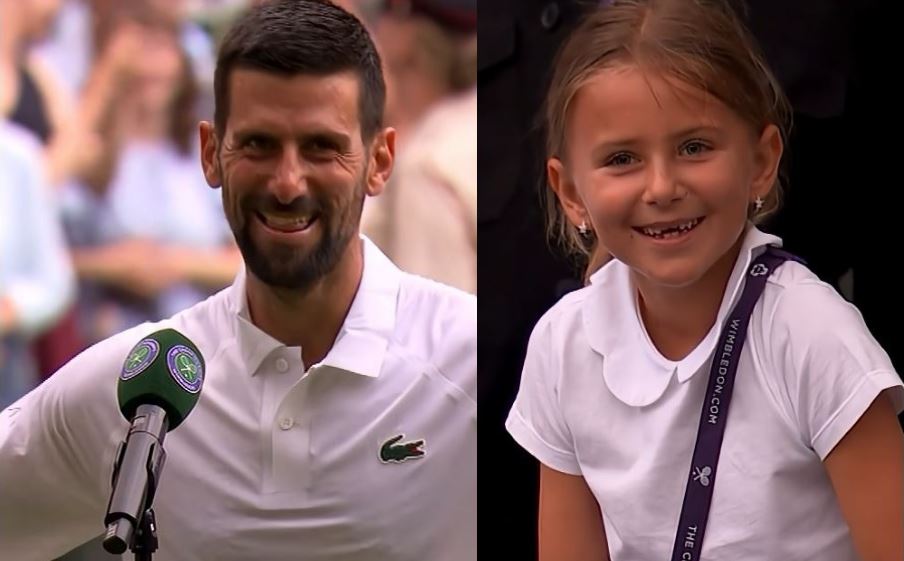Novak Djokovic’s victory in the third round of Wimbledon on July 5 was already newsworthy. It was no small accomplishment to win his 100th singles match on Centre Court. Surprisingly, though, his 7-year-old daughter Tara’s endearing dance from the stands was the most talked-about moment. It turned a customary post-match moment into something surprisingly endearing and universally loved.
The “Pumpa” dance has become a delightful viral sensation in recent days. The name is derived from the Serbian word for “pump,” which is appropriately rendered as “Pump It Up” in English. Although Novak had been observed imitating the dance during earlier games, he stopped in the middle of the interview to gesture to his daughter in the stands. He grinned proudly and remarked, “Look, my daughter is doing it now.” Encouraged, Tara started to move her arms in a rhythmic manner, first down, then side to side, and finally up, with a confidence that immediately captivated the audience.
Simple Table – Novak Djokovic & Daughter Tara
| Detail | Information |
|---|---|
| Full Name | Novak Djokovic |
| Daughter’s Name | Tara Djokovic |
| Daughter’s Age | 7 years old (as of 2025) |
| Profession | Professional Tennis Player |
| Notable Milestone | 100th Wimbledon singles match win (July 5, 2025) |
| Family Tradition | “Pumpa” Dance (“Pump It Up”) |
| Spouse | Jelena Djokovic |
| Other Child | Stefan Djokovic (10 years old) |
| Nationality | Serbian |
| Venue of Dance | Wimbledon Centre Court |
| Dance Debut | During Novak’s post-match interview, Wimbledon 2025 |
The crowd responded right away. Cameras panned in, cheers echoed through the stands, and applause erupted as Tara’s naive happiness provided a counterpoint to the precision and tension that typically characterize Wimbledon’s most memorable moments. The fatherly gleam in Novak’s eyes offered a remarkably clear glimpse into his personal joy for fans accustomed to seeing him calm and focused.
Novak celebrated fatherhood by performing that dance, not just a victory. This instance connected two identities in the context of professional sports, where athletes frequently divide their roles. He was now more than just the Grand Slam legend; he was a father who supported his daughter with the same fervor that she showed for him.
Tennis has leaned more and more toward humanizing its players over the last ten years. For fans who are yearning for genuineness, these infrequent glimpses of family life—whether it’s Serena Williams sitting courtside with her daughter Olympia or Rafael Nadal talking modestly about fatherhood—feel especially helpful. In an age of carefully manicured content, Tara’s performance struck a chord on an emotional level and went viral for more reasons than just its cuteness.
The spontaneity of the moment added to its allure. There was no PR strategy behind the dance. It was neither stylized nor staged. It was natural. Tara, who was wearing casual clothing in the Wimbledon stands, responded to attention rather than seeking it. Viewers were reminded of what sports can still offer beyond numbers and records by this type of uncensored expression, which was remarkably reminiscent of an honest childhood memory.
Novak himself understood its significance. He chuckled as the audience joined in, saying, “She’s the master.” It was a subdued but impactful statement that demonstrated respect for his daughter’s zeal as well as for the value of having fun when competing. This playful family moment stood out gracefully in a setting where every detail is scrutinized and every mistake is criticized.
There were no fans, no family hugs, and no post-match laughter during the pandemic, which made sporting events seem more impersonal. The way that the return of such intimacy alters our understanding of greatness is especially novel. In addition to their accomplishments, athletes are heroes for their ability to maintain their humanity, include their kids in significant events, and celebrate life’s small rhythms in front of millions of people.
Djokovic reminded audiences that success doesn’t have to be stoic by displaying strategic vulnerability. In the stands, it occasionally joyfully pumps its fists. This minor narrative change is a part of a larger social movement that promotes presence, emotion, and balance even in high-performance settings.
It’s interesting to note that Tara’s increased prominence coincides with Djokovic’s prior declarations in interviews that she has no interest in tennis. He told reporters in Australia, “She enjoys ballet and gymnastics.” Even though it seems insignificant, that detail gives the narrative another depth. Her Wimbledon performance was an attempt to carve out her own moment rather than emulate her father. That independence is especially liberating.
The picture of Tara dancing joyfully without coaching or restraint provided a new role model for young girls around the world. She had no intention of impressing anyone. Legacy wasn’t a burden for her. She was just joyful, expressive, and present. Many contemporary parents, particularly those in the public eye, strive to instill these traits in their kids. This moment was made more charming by the fact that Novak and Jelena, who are notoriously private about their children, let it happen organically.
We’ve noticed a noticeable rise in endearing exchanges between athletes and their kids since the advent of this new public love for athlete families. A cultural shift is taking place, as evidenced by LeBron James’ courtside embraces and Lionel Messi’s family-friendly festivities. Once confined to locker rooms, these exchanges are now proudly on display, where they belong.
Djokovic demonstrated a particularly contemporary kind of masculinity—one in which tenderness and victory coexist—by incorporating his daughter’s dance into his celebration. This version welcomes vulnerability as a source of strength rather than minimizing it. That evolution is highly necessary and timely.

